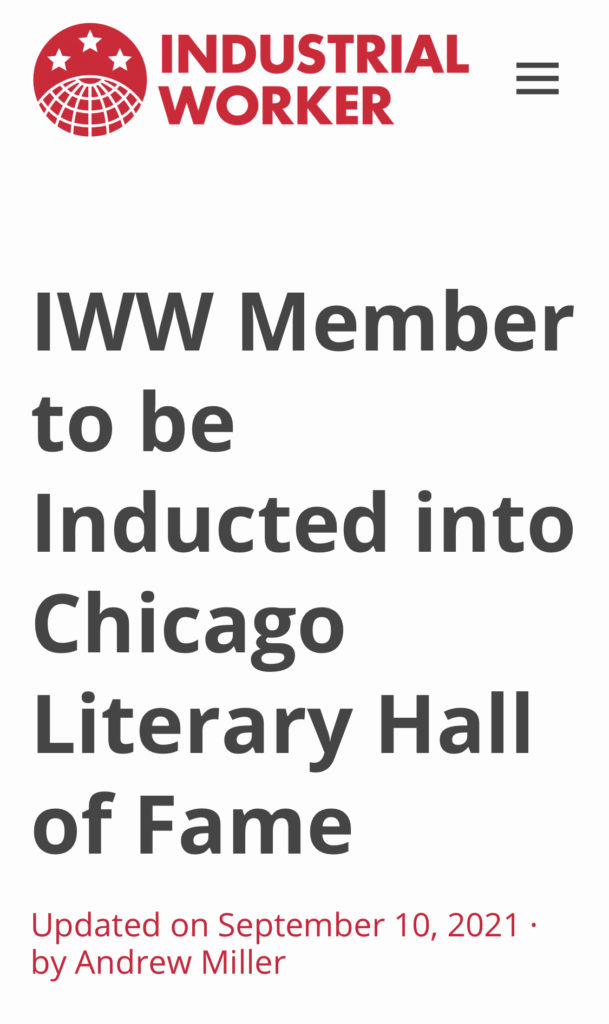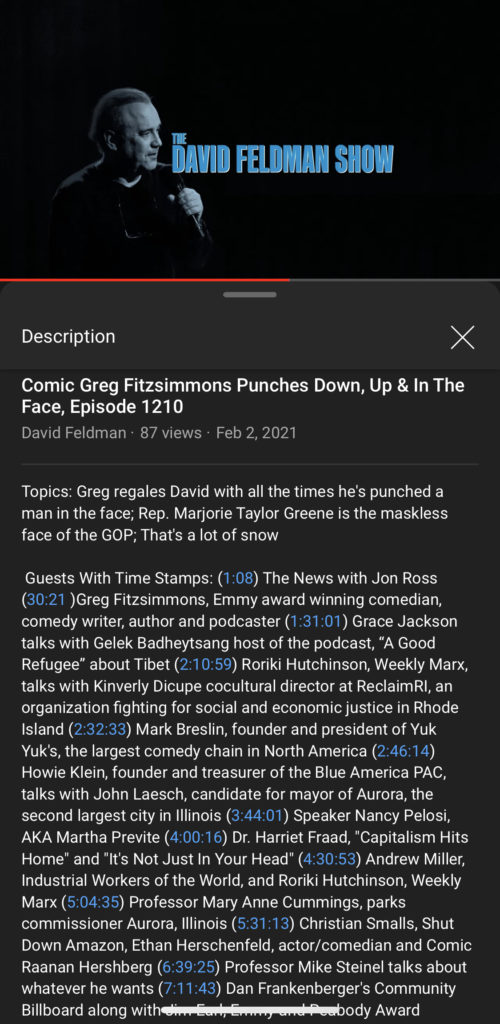
Click through to read my latest article for the Industrial Worker.
Fellow Worker Carlos Cortez Inducted into Chicago Literary Hall of Fame
By FW Andrew Miller
The IWW has a long tradition of appealing to working class artisans and there’s no better example of that than Carlos Cortez. During Cortez’ life he created many iconic posters memorializing the struggles of fellow workers as well as through his poetry, songs, and contributions to IWW publications like The Industrial Worker. The culmination of his life’s work is being celebrated by the Chicago Literary Hall of Fame where he will be officially inducted on September 19.
Cortez was born into the struggle. His father, Alfredo Cortez, was an indigenous Mexican of the Yaqui from the Sinaloa region. Alfredo Cortez fought in the free speech riots in San Diego in the early 20th century, ultimately serving as an organizer for the IWW. His mother, Augusta Ungerecht, was a German immigrant working as a socialist party organizer and poet when the two met at a socialist party convention in Minnesota. By 1923 Cortez was born and the family lived in a largely immigrant section of south Milwaukee.
As an only child, Cortez spent a lot of time watching his parents organize within their community, this helped instill in him a class consciousness at an early age. In grade school he learned to turn his drawings into wood and linoleum cut blocks, allowing him to print as many copies as he liked. As he grew, Cortez learned multiple languages from his neighbors, along with the struggles they faced as poor immigrants.
There is a long history of Mexican artists using wood block printing to spread political messages and Cortez was keen to join those ranks. By the time World War II had rolled around Cortez had made up his mind that there was no nation worth fighting for, only the working class struggle. As his mother was devoutly pacifist and neither of his parents believed that the war would benefit the international working class, Cortez chose to become a conscientious objector.
At a time when nationalism was running high in the United States, Cortez’ decision landed him in federal prison for two years. According to his close friend and confidant, poet Carlos Cumpian said, “The conscious expression of his writing and art prior to being in prison was not yet radical, but he had time to read in prison and formulate his own philosophy that lead to the bigger internationalism. [Cortez] really found his politics in prison where he had nothing but time to read and talk about international struggles with other prisoners, many of whom objected to the war for religious beliefs.”
Although Cortez and his family were friends with Dorthy Day (of The Catholic Worker), he himself was not religious. His working class perspective made him question what the churches were doing with their wealth, and even as a pacifist, Cortez believed the Spanish Civil War was necessary to protect the Spanish workers from abuses by the church and fascist state.
“Cortez felt war was generally orchestrated by the rich and he never wanted to fight other workers. He would’ve gone to Germany to kill Hitler but he wasn’t going to go and kill other working class people,” Cumpian said. “He came out of prison and he was shunned by his so called friends. His dad and relatives accepted what he did, but he still felt like an odd guy out.”
After prison Cortez joined the IWW and found his niche for agitation through art and writing. In these post-prison years he began dating a Japanese American women, whose stories of abuse during the war years further radicalized him. It was this woman who introduced him to the haiku form. Cortez was drawn to highly accessible poetry in the same way he was drawn to making easily reproduced art. As an outsider, he was drawn to the beat poets of the time, particularly Kenneth Patchen, for their exploration of non-conformity. Even in short form, Cortez focused on narrative poetry, telling the stories of the daily lives of working people. Eventually these narratives became part of his long-standing Industrial Worker column titled “The Left Side.”
While Cortez never made a living from his writing or art, he certainly left behind a legacy that far overshadowed his life as a wage slave. Cortez’ woodcuts and linoleum cuts were left to the National Museum of Mexican Art with the explicit responsibility of reprinting any of Cortez’ work that becomes too expensive for a worker to afford.
One of those prints, of Joe Hill, remained on the wall of his Chicago apartment until his death in 2005. Cortez loved music and was fond of rebel songs, but had a particular soft spot for the blues. Although he wasn’t a musician himself, he does have song writing credits in the IWW Little Red Songbook for “Out of Work Blues.”
Working at the Topping and Co. International House, prior to leaving Milwaukee for Chicago, is where Cortez met several musicians and ultimately meet his wife Marianna, the sister of Niko Topitzes (Nick Topping). For the sake of work and his love of music, Cortez and his wife moved to Chicago, near DePaul University at 2117 N. Clifton Ave.
In Chicago Cortez continued to work various factory jobs, salting in at some and organizing others outright. Around 1970 was when Cortez and Cumpian became friends after a chance meeting in the apartment building that led to Cortez signing Cumpian up for his red card.
“He invited me to go and hang out with him and his fellow workers, listening to music and such,” Cumpian said. “Eventually the FW’s let me know about a job and a bunch of us signed up – the place made lava lamps and blacklights and distributed them – this ended up being my first strike. We would get locked into the building during shifts, the dock workers were the only ones that could come and go. They did this to prevent theft. Working there was the first time I ever saw a dead person, there was a man frozen to death in our doorway. We were forced to eat our lunch on our work space. There was nothing like a medical kit or anything. So we definitely wanted to organize the shop.
“[Cortez] helped lead it. We were able to get the truckers to respect our picket and we won. He always made sure his circle of friends were all on board with protesting and being public about it, marching with signs and other materials.”
Probably the most famous story about Cortez’ direct action was when he worked at what he called “the bubble factory”, a soap manufacturing plant near his apartment. During a winter storm that prevented the supervisors and managers from getting to the factory from their suburban homes, Cortez and his fellow workers went in to work and ran the production line all day on their own. When asked by management how they did it, Cortez explained that it was easy, and much more productive than if the bosses had been there.
Cumpian said he believes Cortez is being honored because Chicago is a union town, and Cortez understood that intimately.
“Cortez, was one of the few contemporary writers who wrote about unions, immigrants, and workers of all kinds,” Cumpian said. “He put together ‘Working People’ and ‘Two December Songs’ that tackled the topics of immigration and the working life. ‘Requiem for a Street’ is probably his poem that ties him most to Chicago. It’s a narrative poem and brings about the harmony of Maxwell Street, the shopping district of the poor. This wasn’t just a place for the poor to go to shop, but there were corner performances like blues music, and it was a place where immigrants would find others speaking their native languages. This was before the mall-a-fication of everything. His poems about police brutality and protest put him squarely in the awareness of working class Chicago; in both English and Spanish.”
Cortez would sign his work differently based on topic or audience as well. Sometimes as Cortez, sometimes as Red Cloud, sometimes in Spanish, and sometimes with only his X number: x321826.
Don Evans, director of the Chicago Literary Hall of Fame, said that while “the poetry was the first and foremost consideration, the selection committee did consider his whole body of work. So not only did he publish significant poetry, but it was connected to his lifelong mission of supporting workers, worker rights, artists, and relentless pursuit of social justice. [Carlos Cumpian] really has done everything he can to help keep the work of Cortez circulating. The poetry landscape is very unforgiving and so having someone like Cumpian grind away for years is a gift.”
Cumpian will present the statue to the National Museum of Mexican Art at City Lit Theater on September 19.
According to Evans, one of primary reasons behind Cortez’ induction is that the committee asked, “what was his resonance? We looked out into the future and felt Cortez’ work will continue to resonate for years to come.”
“There’s a kind of texture to his poems,” Evans said. “What I respond to is the feeling you get that you’re inside his world and you feel it is much different than the world you’ve had described to you. Cortez’ world is a rigged world and for Cortez there’s such passion and intelligence but also it’s more than a vision, you can feel how much ownership he had in this world he’s sharing with you. This is not an idyllic world, which is why he worked so hard to make more just, to fight for justice.”

I am honored to have been included once again in the Ohio Art Council’s Riffe Gallery exhibition “After Hours”. Having the opportunity to share my work with a broader audience than I have on Instagram (@xandrewmillerx) is truly appreciated. Additionally, during the Juror’s Tour, juror Ken Emerick selected my piece as one to highlight and discuss with gallery director Cat Sheridan. Below is the video from that.

Click the photo or this link to listen to a discussion about unions, workers rights, and related issues starting at the 4:30:53 mark.